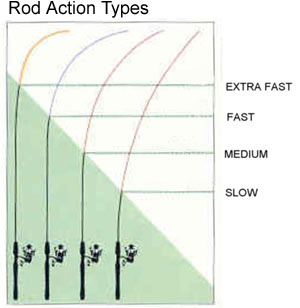Salt Water Rod and Reel Information
Below are descriptions of common saltwater fishing rod and reel terms and what you need to know about each to make an informed decision. Take your time, do your homework, and you can find a rod and reel combination that will become a trusty friend for a long time.Common Saltwater Fishing Rod Terms
 Action
Action Action refers to how much the rod deflects or bends when you put pressure on the tip. A fast action rod will bend in only the top 3rd or less of the blank, a medium or moderate action will bend in the top half or so and a slow action will bend starting in the lower 3rd of the rod. Fast action rods are great for short to long casting distances and where single hooks are the rule, such as worm and jig fishing. Medium action fishing rods provide a little more casting distance and still offer good responsiveness for setting your hook.
Power
Rod power is the rod's strength or ability to lift weight from the tip. Power ratings are mostly reflective of the rod's application, a heavy power rod would be suited for offshore trolling and a medium power rod might be designed for surf casting. Power is closely tied to the reccomended line weight.
Responsiveness
Responsiveness refers to the kenetic energy stored in the rod when it is bent, or how fast the rod snaps back during the cast. Responsiveness and power are closely tied, a rod with a lot of power will be less responsive. A rod that is highly responsive is best suited for casting and can improve casting accuracy dramatically.
Common Saltwater Fishing Reel Options
Ultimately your first choice with a reel has to be between a baitcasting reel and spinning reel. This choice is mostly determined by how you plan to use the reel and your personal preferences.
Drag Systems
With baitcasting reels, anglers have the choice of either a star drag or lever drag system. With a star drag system, drag pressure is increased or decreased by turning a star shaped wheel just inside of the handle. While star drag systems are simple to operate and are fine for most applications, lever drag systems typically supply smoother, significantly more consistent performance. Most lever drag reels also allow for drag to be adjusted in more precise increments than star drag systems and are therefore preferred for most trolling applications.
 Spinning reels have two options as well, front drag and rear drag models. As it sounds, the difference between the two is in the location of the drag system. Front drag spinning reels generally feature larger, multiple disc drag washers that deliver a higher level of performance and durability and as a result are better suited for larger fish.
Spinning reels have two options as well, front drag and rear drag models. As it sounds, the difference between the two is in the location of the drag system. Front drag spinning reels generally feature larger, multiple disc drag washers that deliver a higher level of performance and durability and as a result are better suited for larger fish. Gear Ratio
A fishing reel's gear ratio refers to how many revolutions the spool makes with each complete turn of the handle. Reels with high gear ratios are better for working lures briskly back to the boat, or quickly gaining line when a fish charges the boat. Reels with lower gear ratios provide greater cranking power for bottom fishing and trolling.
Level Wind Mechanisms
Lever wind mechanisms work back and forth across baitcasting reels to evenly re-spool the line as it is retrieved. While this may be convenient, these reels are usually more prone to mechanical failure and are often not capable of handling very heavy line weights required for offshore fishing.
Ball Bearings
All fishing reels use ball bearings to maintain smooth fluid movement of the spool. Typically the more bearings a reel has, the smoother it will be.





















